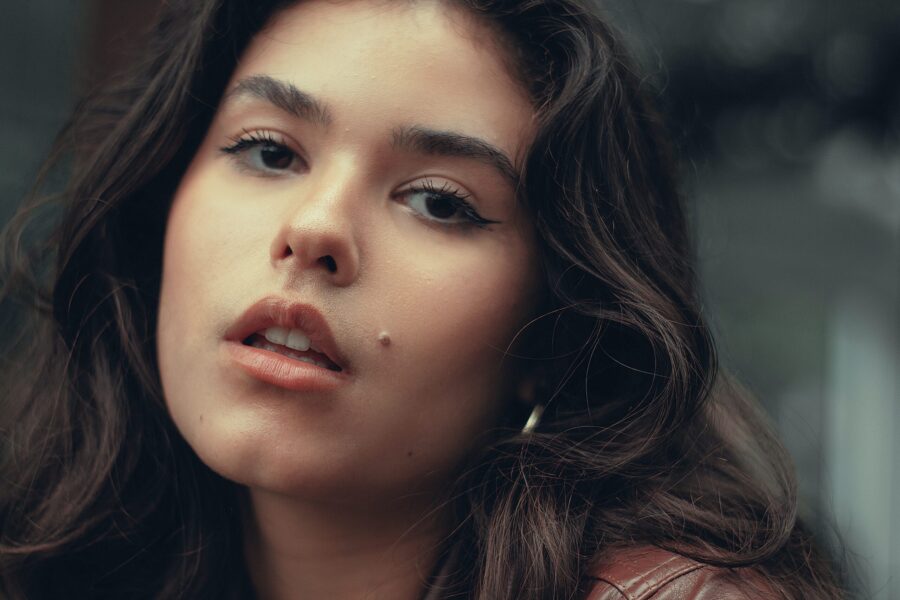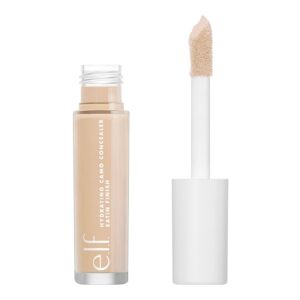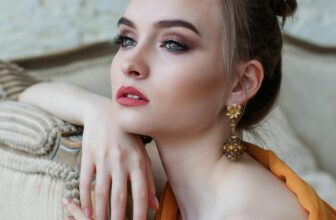
Photo by Becca Correia:
Introduction: Explaining Beauty Marks
Beauty marks, commonly referred to as moles, have been a source of fascination for centuries. These small round or oval-shaped marks on the skin tend to be dark in color and can be found on various parts of the body such as on the face, neck, arms and legs. While some people view beauty marks as imperfections on their faces or bodies, others view them as symbols of unique beauty and individuality.
Beauty marks have different symbolic meanings depending on culture, history and location on the body. In ancient Chinese culture, a mole on the forehead was seen as an indication of intelligence; similarly in Indian culture a mole on the left side was thought to bring good luck. Western civilization adopted beauty marks during the 18th century and saw them as symbols representing beauty and sophistication.
Beauty marks can be harmless and add character to one’s appearance, but others may cause concern. If a beauty mark changes in size, shape or color it’s essential to get checked by a dermatologist in order to rule out skin cancer as the cause.
The Science of Beauty Marks: What Causes Them?
Beauty marks, or moles, are composed of clusters of melanocytes–cells responsible for producing the pigment that gives skin its color–located at the base layer of skin and distributed evenly throughout.
Beauty marks are caused by both genetic and environmental factors, with some individuals born with a predisposition to developing more than others. Sun exposure may also contribute to an increase in skin-colored spots.
Though most beauty marks are harmless, some may cause cause concern. People with fair skin or those who spend a lot of time outdoors in the sun have an increased likelihood of developing skin cancer, so it’s important to monitor any changes in size, shape or color of a beauty mark as well as any symptoms like itching, bleeding or pain.
Beauty marks can be removed for aesthetic or medical purposes through surgical excision, laser treatment or cryotherapy. Before undergoing any procedure it’s essential to consult a dermatologist first.
DERMA E Vitamin C Concentrated Serum with Hyaluronic Acid
Historical Significance of Beauty Marks
Over centuries, beauty marks have had a special significance in various cultures and societies. In ancient times, they were seen as signs of beauty and were often created using makeup or ink. In some cultures, beauty marks served to signify social status – royalty and nobility would wear them as tokens of their wealth and power.
During the 18th century, beauty marks became increasingly popular in Western culture, particularly among aristocracy. Women would use makeup to craft artificial marks of various shapes and sizes with each having its own symbolic significance; for instance, a beauty mark above the lip was called a mouche and symbolized coquetry and flirtatiousness.
Beauty marks had a special place in art and literature. Portraits often used them to enhance the subject’s beauty or serve as symbols of their personality; similarly, literature employed beauty marks to describe characters’ physical features or innermost thoughts.
Beauty marks may have lost some of their aesthetic value over time, but they remain an attractive feature that many people prize for themselves. Nowadays, many people proudly display their marks as symbols of individuality and self-expression.
e.l.f, Hydrating Camo Concealer
Cultural Meanings of Beauty Marks Around the World
Beauty marks, or moles, have different cultural meanings around the world. In Chinese culture, moles are believed to hold secrets about someone’s destiny and personality. A mole on one’s chin may signify beauty and wealth while one on the nose could indicate leadership abilities.
Indian culture holds that moles possess significant symbolic value in astrology. The position and shape of a mole can provide insights into someone’s personality, future plans, and relationships; for instance, one on the right cheek may signify financial success while one on the left cheek signifies a happy marriage.
Some African cultures view moles as a sign of beauty and have celebrated them for centuries. Some tribes believe that beauty marks carry spiritual power, protecting individuals from evil spirits and demons.
Western culture has long seen beauty marks as a signifier of aesthetic excellence and sophistication. During the 18th century, women would use makeup to create artificial beauty marks on their faces, each bearing its own symbolic significance.
Beauty Marks in Astrology: What They Reveal About Your Personality
Astrology holds that beauty marks, or moles, contain symbolic meaning about a person’s character and future. According to ancient Indian astrology, the position, shape, and color of a mole can provide insight into one’s character traits as well as life path.
For example, a mole on the forehead is thought to be indicative of intelligence and creativity, while one on the earlobe suggests good communication abilities. A mole on the cheek could symbolize wealth or happiness while one on the chin suggests leadership qualities.
A person’s mole’s size and color can provide insight into their personality. A large, dark mole is thought to symbolize strength of character and determination; on the other hand, a small and light-colored mole may signify gentleness and sensitive nature.
It is essential to remember that while astrology can offer some insight into someone’s personality, it should not be taken as gospel truth. There is no scientific proof whatsoever supporting the idea that beauty marks reveal someone’s destiny or future.
Beauty Marks and Health: Are They Harmful or Benign?
Beauty marks, or moles as they’re commonly known, are typically benign and harmless skin growths caused when cells that produce pigment (melanin) cluster together. While most beauty marks are harmless, some may indicate an increased risk for skin cancer.
It is essential to monitor any changes in a beauty mark, such as its size, shape, color and texture. If the mark begins to look different or has any unusual features it should be evaluated by a dermatologist for further evaluation.
When monitoring changes, ABCD and E can be used as guides: A represents asymmetry; B represents irregular borders; C represents color variations; D represents diameters exceeding 6 mm; and E represents evolving shapes.
If a dermatologist suspects that a beauty mark may be cancerous, they may perform a biopsy to take a sample of skin for testing. If the biopsy results indicate cancer, further treatments such as surgery to eliminate the affected area can be recommended.
Neutrogena Ultra Sheer Dry-Touch Water Resistant and Non-Greasy Sunscreen Lotion
The Celebrities with Iconic Beauty Marks and Their Stories
Beauty marks, or moles, have been a signature feature of many legendary celebrities throughout history. These unique features add character and charm to their looks, setting them apart from others in the industry.
Marilyn Monroe was one of the most renowned celebrities with a beauty mark: her small mole above her lip, affectionately known as her “beauty spot,” became an iconic part of her look and often imitated by admirers.
Cindy Crawford was another famous celebrity with a beauty mark: she had an elevated mole above her lip which became one of the defining features of her style and earned her the title “mole lady” within the fashion industry.
Celebrities known for their beauty marks include Madonna (small mole on cheek) and Eva Mendes (mole above eyebrow). These unique features have often been seen as adding to their charm and beauty, distinguishing them from other celebrities in the industry.
Beauty Marks as Fashion Statements: How to Embrace Them
Beauty marks, or moles, have long been seen as a trendy and desirable feature in the beauty industry. In fact, some people even go so far as to create faux beauty marks with makeup or temporary tattoos for an unique and distinct aesthetic.
Embrancing your natural beauty marks can be a great way to express yourself and add character to your appearance. To make them even more noticeable, use makeup to accentuate them – for instance, dark eyeliner can be used to draw attention to moles above or on either cheek.
If you don’t already have a beauty mark but would like to create the look, makeup pencils or temporary tattoos can be used to create one. This is an interesting and creative way to express yourself while experimenting with your appearance.
Removing or Altering Beauty Marks: Pros and Cons
Beauty marks, or moles, can be seen as defining features of someone’s appearance. However, some individuals may experience self-consciousness about them and consider removing or altering them. There are pros and cons to considering such changes; therefore, it’s essential to carefully weigh all options before making your decision.
The benefits of having beauty marks removed or altered include improved self-esteem and confidence. Some individuals may feel their marks make them stand out in a negative way or detract from their overall appearance. By eliminating or changing these marks, people can feel more at ease in their skin while increasing their level of self-assurance.
However, there are also potential drawbacks to removing or altering beauty marks. The most serious potential danger is the risk of scarring or damage to skin tissue during surgery for removal, which could leave behind a scar or other imperfections. Furthermore, changing a beauty mark may give an unnatural or unbalanced appearance.
Conclusion: Celebrating Individuality and Diversity Through Beauty Marks
In conclusion, beauty marks are unique and defining features of an individual’s appearance. Rather than viewing them as imperfections, we should celebrate them as parts of our individuality and diversity. Beauty marks possess cultural and historical significance as well as potential astrological meaning, making them popular fashion statements. Before opting to remove or alter one’s beauty mark, one should carefully weigh the pros and cons before making a decision. Ultimately, beauty marks should be celebrated and accepted for what they are: unique expressions of our individual beauty.
Also Check: The Essence of Natural Beauty in Women










